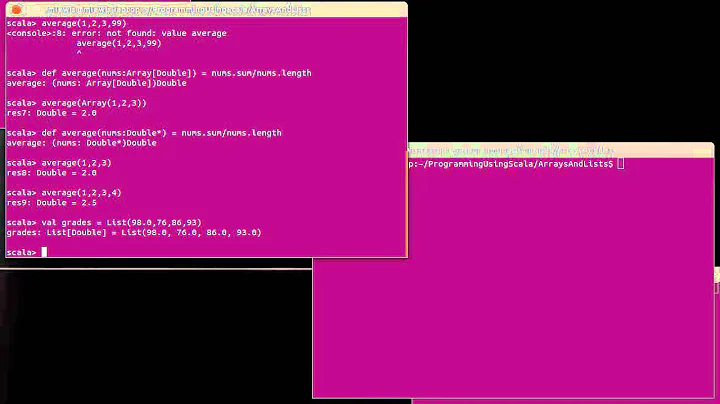Why doesn't the Scala List have a size field?
Solution 1
One cannot say the size field was dropped, as such list without the size have existed for 50 years since LISP where they are ubiquitous and they are very common in ML and Haskell too, both influential in scala.
The basic reason is that list is a recursive structure. A non empty List is Cons(head: A, tail: List[A]) — except that Cons is in fact called :: to allow a convenient infix notation. You can access the tail (the list without its head element) and that is a list too. And this is done just about all the time. So having the count in the list would not mean adding just one integer, but as many integers as there are elements. This is feasible, but certainly not free.
If you compare with java's LinkedList, LinkedList has a recursive implementation (based on Node, which is more or less like Cons, but with links in both direction). But a LinkedList is not a Node, it owns them (and keep their count). So while it has a recursive implementation, you cannot treat it recursively. It you wanted the tail of a LinkedList as a LinkedList, you would have to either remove the head and have your list changed or else copy all the tail elements to a new LinkedList. So scala's List and java's LinkedList are very different structures.
Solution 2
Because maintaining this field would
- Add memory overhead to all lists;
- Add slight time overhead on every list creation.
In Java normally a LinkedList is created, and then manipulated without creating new lists by adding/removing elements; in Scala there are many Lists created.
So it was decided that the overhead isn't worth it.
Solution 3
The "disadvantage" of O(n) complexity is not as big as you might think. Martin Odersky mentioned in a talk that (if I remember correctly) 90% of all lists created in all programs in any computer language have a size of 4 or less. (This was in the context of immutability and efficiency)
Therefore, O(n) access time for size is not such a big overhead for most lists created, and, as others have mentioned here, memory savings more than compensates for this.
Solution 4
List defines size :
> List(1, 2, 3).size
res4: Int = 3
which has linear o(n) execution time. If you really need a constant time, you should consider the mutable ListBuffer that provides a constant time size implementation.
Solution 5
Have you checked the length field?
Related videos on Youtube
python dude
Updated on July 30, 2022Comments
-
python dude almost 2 years
Coming from a Java background, I'm wondering why
Listin Scala doesn't have asizefield like its Java equivalentLinkedList. After all, with a size field you'll be able to determine the size of the list in constant-time, so why was the size field dropped?(This question refers to the new collection classes in Scala 2.8 and later. Also, I'm referring to the immutable
List, not the mutable one.)-
kapex over 12 yearsIt's
size()in Java, a function. -
Didier Dupont over 12 yearsBut the function is backed by a field, which makes it O(1). Scala List has no such field, for good reason, but that makes accessing the length O(n).
-
 huynhjl over 12 years"python dude" comes from a Java background? python doesn't refer to the language, does it?
huynhjl over 12 years"python dude" comes from a Java background? python doesn't refer to the language, does it? -
python dude over 12 years@huynhjl: Am I not allowed to have more than one background? ;-)
-
 Mechanical snail almost 12 years@huynhjl: No. It means he's a male python.
Mechanical snail almost 12 years@huynhjl: No. It means he's a male python.
-
-
Tomasz Nurkiewicz over 12 years
lengthis a method thst traverses the whole list, hence havingO(n)complexity. The OP asks why there is nolengthfield with constant time access. -
python dude over 12 years@Udo Held: Your link is from Scala 2.7.7, which I have no experience with. My question is based on Scala 2.9+, and specifically on the book "Programming in Scala", 2nd Ed., where it's stated in chapter 16 that determining the length of a List is linear in the number of elements.
-
python dude over 12 yearsWhich version of Scala is this? Before or after 2.8?
-
Udo Held over 12 yearsscala-lang.org/api/current/scala/collection/mutable/… has the length as well and is 2.9. You will find size there as well which is equivalent to length.
-
David over 12 yearsat least since 2.8 and later. See : scala-lang.org/api/2.8.0/scala/collection/immutable/List.html
-
 Admin over 12 yearsIs this constant-time though? it says "equivalent of length"
Admin over 12 yearsIs this constant-time though? it says "equivalent of length" -
Didier Dupont over 12 yearsI think the question referred to the immutable List, which is the default one in scala. It has no length field
-
David over 12 yearsIn fact your are right. List has linear o(n) size execution time has we can see on the code : lampsvn.epfl.ch/trac/scala/browser/scala/tags/R_2_9_0_1/src//…
-
Daniel C. Sobral over 12 yearsIn fact, adding a
sizefield would double the size of a cons from 8 to 16 bytes, given that objects are allocated in multiples of 8 bytes. -
David over 12 yearsexact but it's a o(n) size implementation. The subject was that LinkedList java implementation have a size field that returs the size in constant time.
-
ches almost 10 yearsFWIW immutable
Vectoris an indexed data structure with efficientlength(among other indexed operations)—so there are alternatives to sacrificing immutability if you have no other good reason to do so. -
ayvango almost 9 yearsLists are strict in scala. So every time Cons applied it knows size of the tail and so can increase by 1 and write it to a specific field. Like
Cons(head : A, tail : List[A]) { override val size : Int = tail.size + 1}. It is possible, but may be considered too space hungry.


![Lost Sky - Where We Started (feat. Jex) [NCS Release]](https://i.ytimg.com/vi/U9pGr6KMdyg/hq720.jpg?sqp=-oaymwEcCNAFEJQDSFXyq4qpAw4IARUAAIhCGAFwAcABBg==&rs=AOn4CLDishouj7NaJR6sFdyQZfTbNZhSiw)






